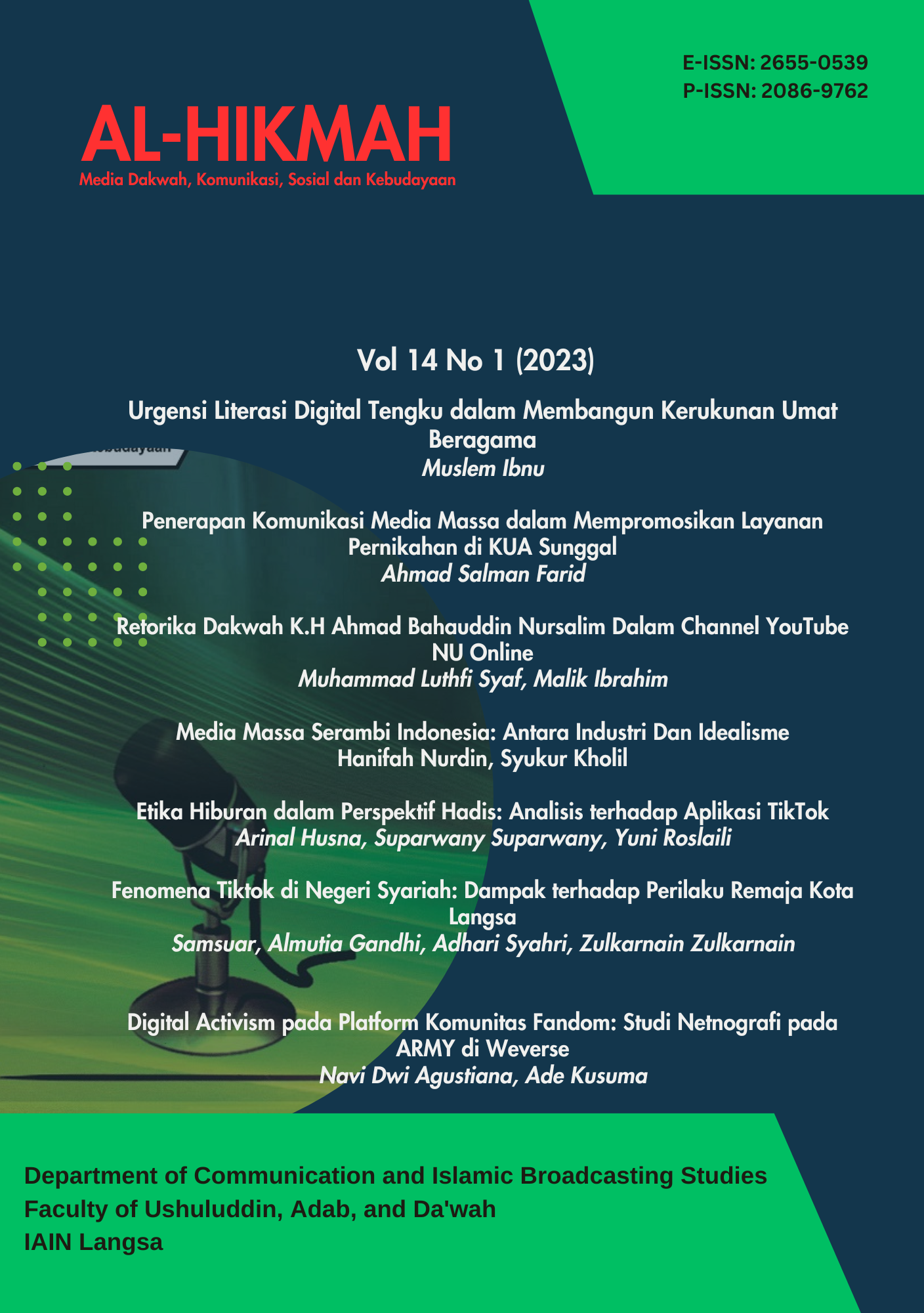Main Article Content
Abstract
The TikTok application is an entertainment medium that allows its users to do freestyle, such as dance, lip sync, challenges, etc., which was once banned in Indonesia because it contained negative content. This study discusses the ethics of entertainment from a hadith perspective, with the main focus being the TikTok application media. This qualitative research is library research with a descriptive analysis approach. The theory used is thematic hadith theory. The thematic hadith method is carried out by tracing the hadiths using the lafadz "لَهْوٌ" and "لَعÙب" and is limited to only the hadiths contained in the Polaris sittah book, while the criticism of sanad and matan is only carried out on one path and not on all tracks. Primary data sources include the books al-Kutub al-Sittah, Mu'jam al-Mufahras, Tahzib al-Kamal, and Syarah Hadith, while secondary sources include books, articles, and scientific writings about TikTok and entertainment, as well as Software Hadith Lidwa Pusaka and Maktabah Syamilah. The results of the study show that when viewed from the hadiths of the Prophet Muhammad, entertainment is permissible as long as it is in accordance with the ethics of entertainment, such as not being excessive and negligent, not contrary to Islamic law, and not arousing lust. The TikTok application has many negative uses, such as dancing with nakedness and tabarruj, which can arouse lust, singing or lip syncing accompanied by neglectful music, and using sentences that are not educational, as well as the many types of content that can make a person addicted and inattentive. Therefore, the author considers that this application is irrelevant to the hadiths of the Prophet regarding entertainment.
Keywords
Article Details

This work is licensed under a Creative Commons Attribution 4.0 International License.
References
- Al-Bukhari, A. ’Abd A. M. bin I. (1400). Al Jami’ Al-Sahih (Juz 1, p. 512). Maktabah as-Salafiyah.
- Al-Munziri, A.-H. Z. al-D. ‘Abd al-‘Azim. (2008). Mukhtasar Sahih Muslim (Ringkasan Sahih Muslim). PT. Mizan Pustaka.
- Al-Naisaburi, A. al-H. M. bin al-H. bin M. al-Q. (2008). Sahih Muslim (p. 260). Dar al-Kutub al-’Ilmiyah.
- Al-Nasa’i, A. ’Abd al-R. A. bin S. bin ’Ali. (n.d.). Sunan al-Nasa’i. Maktabah al-Ma’arif li al-Nasri wa al-Tauzi.
- Fulaifil, H. Z. (2012). Khamsan Nahyan Syar’iyan lil Nisa’ (50 Larangan Bagi Wanita) (F. Sanusi, Ed.). Zamzam.
- Ibnu Majah, A. ’Abd A. M. bin Y. al-Q. (n.d.). Sunan Ibnu Majah. Maktabah al-Ma’arif li al-Nasri wa al-Tauzi.
- Juminem, J. (2019). Adab Bermedia Sosial Dalam Pandangan Islam. Geneologi PAI: Jurnal Pendidikan Agama Islam, 6(1), 23. https://doi.org/10.32678/geneologipai.v6i1.1799
- Khatimah, H. (2018). Posisi Dan Peran Media Dalam Kehidupan Masyarakat. TASAMUH, 16(1), 119–138. https://doi.org/10.20414/tasamuh.v16i1.548
- Madhani, L. M., Bella Sari, I. N., & Shaleh, M. N. I. (2021). Dampak Penggunaan Media Sosial Tiktok Terhadap Perilaku Islami Mahasiswa Di Yogyakarta. At-Thullab : Jurnal Mahasiswa Studi Islam, 3(1), 627–647. https://doi.org/10.20885/tullab.vol3.iss1.art7
- Nasional, D. P. (2008). Kamus Bahasa Indonesia. Pusat Bahasa.
- Rifai, M. dan N. (2020). La’ibun wa Lahwun dalam Al-Qur’an (Suatu Tinjauan Tafsir Tematik). Ushuluddin Adab Dan Dakwah, 3, 19–20.
- Saputra, M. F. (2021). HAK CIPTA DANCE CHALLENGE YANG DIUNGGAH KE APLIKASI TIKTOK. Jurnal Penegakan Hukum Indonesia, 2(1), 70–71. https://doi.org/10.51749/jphi.v2i1.16
- Sholihatul Atik Hikmawati, A. & Luluk Farida. (2021). Pemanfaatan Media Tik Tok Sebagai Media Dakwah Bagi Dosen Iai Sunan Kalijogo Malang. Al-Ittishol: Jurnal Komunikasi Dan Penyiaran Islam, 2(1), 1–11. https://doi.org/10.51339/ittishol.v2i1.215
- Wahyudin, et al. (2019). Etika Ketuhanan. Idea Press.
- Wikipedia. (n.d.). Wikipedia the Free Encyclopedia.
- Yahya, M. H. (2019). 200 Tip Berhibur Gaya Rasulullah Saw. PTS Publishing House Sdn. Bhd.
- Yuslem, N. (2001). Ulumul Hadis. PT. Mutiara Sumber Widya.
